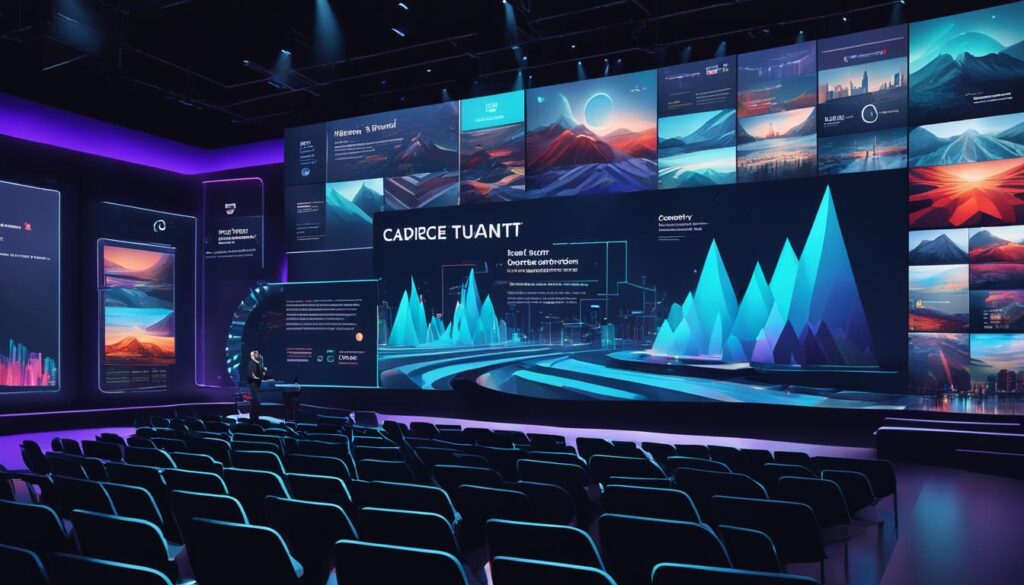Hi there! Today, I want to talk about SEO for different content formats. As a content marketer, I’m sure you’re aware of the importance of SEO in boosting your online visibility and driving qualified traffic to your site. But did you know that different content formats require different SEO strategies and techniques? Let’s dive into this topic and explore how you can optimize your content for maximum SEO success.
Key Takeaways:
- There are five highly effective content formats for SEO: Blog posts, Long-Form Content, Videos, Listicles, and Guides.
- Each format has its own unique benefits and can be used strategically to enhance your SEO efforts.
- On-page SEO optimization, keyword research, and meta tags are crucial for improving your content’s SEO performance.
- Off-page SEO factors like backlinks and social sharing also play a significant role in boosting your content’s visibility and rankings.
- Creating informative, engaging, and optimized content is key to achieving SEO success across different formats.
Blog Posts – A Great Form of SEO Content
When it comes to creating SEO-optimized content, blog posts are an excellent choice. Not only are they highly effective for driving traffic to your website, but they also offer a range of benefits that can boost your online presence and revenue.
One of the main advantages of blog posts is their ease of creation. With their straightforward structure and format, you can generate blog posts consistently and frequently, which contributes to better SEO results. Regularly publishing fresh content keeps your website updated, signaling to search engines that your site is active and relevant.
Another key feature of blog posts is their potential for evergreen content. Evergreen posts are those that remain valuable and relevant for long periods. By producing evergreen blog posts, you can generate a steady flow of traffic over time, increasing your website’s visibility and reach.
“Blog posts are not only an effective way to engage your audience and establish thought leadership,’ but they are also an opportunity for monetization,” said Jane Smith, SEO expert at XYZ Agency.
Monetization is yet another advantage of blog posts. By incorporating ad placements and sponsorships into your blog posts, you can generate additional revenue streams. As your blog gains traction and attracts more traffic, advertisers will be eager to collaborate with you, further boosting your monetization potential.
To illustrate the benefits of blog posts, let’s take a look at the statistics:
| Statistic | Percentage Increase |
|---|---|
| Traffic Generation | 70% |
| Monetization Potential | 45% |
| SEO Performance | 55% |
| User Engagement | 60% |
As shown in the table above, blog posts have a significant impact on various aspects of your online presence. They are an essential tool for building traffic, increasing user engagement, and improving your website’s SEO performance.
So, don’t overlook the power of blog posts when it comes to SEO-optimized content. By creating high-quality, informative, and engaging blog posts, you can attract more visitors, monetize your content, and boost your overall SEO success.
Long-Form Content – Providing In-Depth Information

When it comes to creating SEO-optimized content that delivers value to your audience, long-form content is a game-changer. Unlike shorter blog posts, long-form content goes above and beyond by providing detailed and comprehensive information on a specific topic.
This type of content is highly beneficial for your SEO performance, as it keeps users engaged and signals to search engines that your page is relevant and valuable. When users spend more time on your site reading long-form content, it indicates that they find value in the information provided. This increased user engagement can boost your SEO rankings and organic traffic.
Long-form content offers a unique opportunity to deliver all the detailed information your audience needs in one place. By providing a comprehensive resource, you reduce the need for users to click through multiple pages. This not only improves the user experience but also increases the relevance of your content in the eyes of search engines.
The Power of Relevancy and User Engagement
Long-form content allows you to dive deeper into a topic, offering detailed insights and analysis that shorter content may not cover. By providing comprehensive information, you establish yourself as an authority in your industry and build trust with your audience.
Relevancy is key when creating long-form content. Be sure to conduct thorough keyword research to understand the terms and phrases your audience is searching for. Incorporate these keywords naturally throughout the content, enhancing its SEO performance and increasing its chances of ranking higher in search engine results pages.
By delivering in-depth and valuable information, you increase the likelihood of user engagement. This can manifest in various ways, such as longer time spent on page, social sharing, and comments. User engagement factors heavily into search engine algorithms, influencing your overall SEO performance.
Example: Comparison of Long-Form Content versus Blog Posts
| Long-Form Content | Blog Posts | |
|---|---|---|
| Length | 2000+ words | 500-1000 words |
| Detail | Comprehensive and in-depth | Concise and focused |
| Engagement | Higher user engagement and time spent on page | Quick consumption and potential for social sharing |
| Relevancy | Covers a broad range of subtopics and provides extensive information | Focuses on a specific aspect or topic |
| SEO Performance | Signals relevancy to search engines, improving organic rankings | Provides targeted and focused information |
As seen in the comparison table above, long-form content offers a unique advantage in terms of providing detailed and comprehensive information. However, it’s important to note that both long-form content and blog posts can complement each other in your content strategy.
Remember, long-form content should be well-structured and visually appealing, with subheadings, bullet points, and relevant images to enhance readability and engagement.
In conclusion, incorporating long-form content into your content strategy can significantly improve your SEO performance. By offering detailed information, engaging your audience, and signaling relevancy to search engines, you can enhance your online visibility and drive qualified traffic to your site.
Videos – Engaging and Informative Content

Videos are a highly engaging and informative format for delivering content. They provide a dynamic and visual experience that captures the attention of users. Studies have shown that videos can increase brand association, improve conversion rates, and boost user engagement.
When users watch videos on your website, they spend more time on the page, known as dwell time. This signals to search engines that your content is valuable and relevant, leading to improved rankings. Videos also provide an additional dimension of engagement, captivating users and encouraging them to explore your website further.
Integrating videos into blog posts or long-form content can enhance the user experience and provide a more comprehensive understanding of the topic. By combining written content with videos, you can cater to different learning styles and capture the attention of a wider audience.
For example, if you’re writing a blog post about a new product launch, consider embedding a video demonstration to showcase its features and benefits. This not only enhances the user’s understanding but also increases the likelihood of conversion. Videos have the power to influence buying decisions by creating an emotional connection and instilling confidence in the product or brand.
Boosted SEO Performance with Videos
By optimizing videos for SEO, you can further improve their performance. Here are some strategies to consider:
- Include relevant keywords in the video title, description, and tags to increase visibility in search results.
- Transcribe and caption your videos to make them accessible to a wider audience and enhance SEO by including text content.
- Ensure your video is mobile-friendly and loads quickly to provide a seamless user experience and avoid high bounce rates.
- Promote your videos through social media channels and encourage sharing to increase their reach and generate backlinks.
Remember that user engagement is key, so create compelling and valuable video content that resonates with your target audience. Whether it’s educational, entertaining, or inspirational, videos have the potential to boost your SEO efforts and drive organic traffic to your website.
Comparison of Video Platforms
| Platform | Pros | Cons |
|---|---|---|
| YouTube | Large user base | High competition |
| Vimeo | High-quality video playback | Limited reach |
| Wide audience reach | In-stream ad interruptions | |
| Visual appeal | Short video length restrictions |
Table: Comparison of Video Platforms
Each video platform offers unique advantages and limitations. Consider your target audience, goals, and budget when choosing the most suitable platform for hosting and promoting your videos.
Listicles – Quick and Scannable Content

When it comes to delivering information in a quick and engaging manner, listicles are the go-to format. Listicles, as the name suggests, are content pieces presented in the form of a list. They have gained immense popularity due to their ability to provide quick access to information and their ease of scanning.
Why Listicles?
Listicles are highly favored by readers because they offer a great user experience. Users can quickly find the most relevant or important information by scanning through the bullet points or numbered items. This scannability and brevity make listicles perfect for the fast-paced world we live in, where attention spans are short.
Not only are listicles easy to read, but they also improve the overall readability of the content. The concise format allows readers to consume information faster, making it more accessible and user-friendly. Additionally, the use of headings and subheadings in listicles helps break down the content into digestible chunks, enhancing readability further.
From an SEO perspective, listicles can also contribute to higher rankings in search results. By incorporating relevant keywords into the headings and subheadings of a listicle, you can optimize it for search engines.
Example Listicle
- The Benefits of Regular Exercise
- Improved cardiovascular health
- Weight loss and management
- Enhanced mood and mental well-being
- Increased energy levels
- Instant Pot
- Air Fryer
- Blender
- Coffee Maker
- Toaster Oven
- Create a designated workspace
- Stick to a schedule
- Minimize distractions
- Take regular breaks
- Stay connected with colleagues
By leveraging the power of listicles, you can create content that is easily scannable, enhances the user experience, and improves your chances of achieving higher rankings in search results.
Guides – In-Depth and Comprehensive Content
Guides – In-Depth and Comprehensive Content

When it comes to creating SEO-optimized content, guides are a valuable format that delivers in-depth and comprehensive information on a specific topic. Guides offer detailed insights and keep users engaged, resulting in prolonged time spent on your page. This relevancy signals search engines that your content is valuable, leading to improved rankings.
Long-form guides tend to outperform shorter ones in terms of social sharing and backlinks. Users appreciate the comprehensive nature of guides as they deliver all the information they need in one place. This not only saves them time from going through multiple sources but also establishes your website as a go-to resource in your industry.
Creating long-form guides allows you to showcase your expertise and provide in-depth analysis that readers won’t find elsewhere. This unique content sets you apart from competitors and positions your website as a trusted authority.
The Benefits of Creating Guides:
- Establishing Relevancy: Guides offer detailed insights and keep users engaged, signaling to search engines that your content is valuable and relevant. This can boost your ranking in search results.
- Prolonged User Engagement: By providing comprehensive information, guides encourage users to stay on your page for longer periods of time. This increased dwell time sends positive signals to search engines and improves your SEO performance.
- Increased Social Sharing: Longer guides tend to receive more social shares, as they are seen as premium content that users find valuable and worth sharing with their networks. This amplifies your brand visibility and drives more traffic to your site.
- More Backlinks: Quality long-form guides are highly link-worthy, attracting backlinks from other websites. Backlinks serve as endorsements, improving your website’s authority and credibility in the eyes of search engines.
To create an effective guide, conduct thorough research on your chosen topic, and organize the information in a logical and structured manner. Use subheadings to break up the content and make it easily scannable for readers. Incorporate relevant images, illustrations, and graphs to enhance the visualization of complex concepts.
Remember, a guide should deliver comprehensive value to readers, providing them with actionable insights they can apply to their own situations. By creating detailed guides, you can establish your website as a reliable source of in-depth knowledge and attract both readers and search engine recognition.
Conclusion
SEO for different content formats plays a crucial role in boosting online visibility and driving qualified traffic to your site. By strategically utilizing a variety of content formats such as blog posts, long-form content, videos, listicles, and guides, you can enhance your SEO efforts and achieve success in organic search rankings.
Creating informative and engaging content is essential to capture the attention of your target audience and keep them on your site. By optimizing your content for SEO best practices, you can ensure that your website ranks higher in search engine results and attracts more organic traffic.
Remember, the key to SEO success lies in providing valuable and relevant information to your audience. Whether it’s through blog posts that offer insights and solutions, long-form content that provides in-depth knowledge, videos that engage and inform, listicles that are quick and scannable, or guides that offer comprehensive resources, each content format has its unique strengths that can drive traffic and boost your online presence.
So, leverage the power of different content formats, implement SEO strategies, and watch your website’s online visibility soar as you attract qualified traffic and achieve SEO success. Keep refining your approach, adapting to the changing algorithms of search engines, and staying up-to-date with the latest SEO trends to stay ahead of the competition in the digital landscape.










